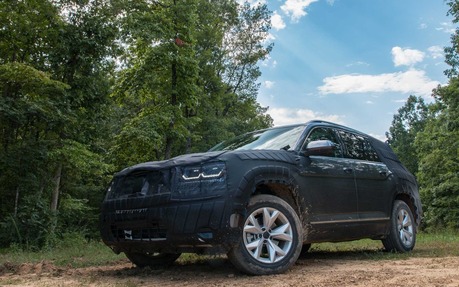Midsize Volkswagen SUV: the King With no Name
This article isn’t a usual road test. You won’t find stars and ratings at the end, nor a recommendation or a proscription.
It’s because the vehicle I drove down in Chattanooga, Tennessee is still in preproduction form. Actually, Volkswagen did start production, but the SUV I tested was so camouflaged that even the cockpit was covered in a thick black sheet of felt.
- Also: VW T-Prime Concept GTE the hybrid SUV you're waiting for
- Also: Volkswagen's SUV Future Unveiled in Beijing
As for the exposed materials in the cabin, they weren’t the final product, and were of poor quality, showing only a foretaste of the eventual properly finished interior.
Ditto for the suspension. If the calibration is set for the production version, we could hear off sounds coming from underneath as we were rolling over bumps, a sign that there probably were several manual adjustments made to the setup.
Anyway, many components were final, which allowed me to get a good idea of what we can expect from this new model. And if what I tried out in the woods of Chattanooga is any indication, it seems as though Volkswagen is about to hit a home run.
A first for VW
It’s the first time that the German brand, which is part of the biggest automotive group in the world, despite the diesel engine scandal, has developed a midsize SUV. Think Honda Pilot, Toyota Highlander and Ford Explorer, among others.
And yet, the company seems to have grasped right away what this segment’s buyers want. We’re not talking about a hybrid powertrain here or any avant-garde gadgetry. Instead, we’re talking about a big, seven-passenger vehicle, available with a front-wheel drivetrain or AWD as an option.
It’s surprising that this SUV, which still doesn’t have an official name, is based on the same platform as the Golf, the Jetta and the Audi Q5. An admittedly flexible platform.

Opening the door, we discover the cockpit of this new SUV for the first time and it’s hard to believe that it’s the brand’s first effort in the midsize segment.
The interior is spacious like I’ve rarely seen. What surprised me the most are the two seats that compose the third row. At six feet tall, with a weight relative to someone who doesn’t exercise, I can take up a lot of room. I’ve never felt at ease sitting in a third-row seat. Not even in the new Mazda CX-9.
However, in the Volkswagen “T,” and let’s call it that because its eventual name should start with a “T” just like the Tiguan and the Touareg, not only do these third-row seats offer plenty of room, but they’re just as comfortable as those in the other rows.
In addition, to climb back there, the second-row seats cleverly incline to create a wide entry space to proceed in the delicate manoeuvre of reaching the third row.
How can these rearmost seats be so great? Maybe because they’re mounted higher off the floor, because I didn’t have the impression that my knees were scraping my forehead. My head should’ve been grazing the ceiling, but it wasn’t, and I had another six inches of clearance.
However, this third-row seat should take up a lot of space, right? Nope. The “T” benefits from well thought-out storage compartments, and the rearmost bench can be stowed away in the floor, which will be 100% flat. Better yet, the second row can also be folded flat to provide a vast cargo area, almost like the one in a cargo van.
So the Volkswagen “T” will no doubt be the first midsize SUV I’d recommend for a family that has three teenagers, as they will likely have no difficulty sitting comfortably in back.
German powertrain
In general, German-engineered powertrains work well. They provide a generous amount of torque over a wide rev range, and their gearboxes don’t hesitate like those that currently equip certain American and Japanese vehicles—we’re talking here about the awful ZF nine-speed transmission found in the Acura MDX and the Fiat 500X.
For the “T,” we don’t know exactly what powertrains will be offered in Canada, but here’s what will be available for the U.S. market, last-minute changes aside. The first one will is the turbocharged, 2.0-litre four-cylinder engine, the second is the 3.6-litre VR6. Base versions will be front-wheel drive, while the optional all-wheel drive distributes more torque to the rear wheels under normal driving for a more dynamic feel. The transmission that will orchestrate all this will be an eight-speed automatic.

I only had the opportunity to try the V6 version. What I can tell you is that the gearbox works wonderfully, and that this 280-plus-horsepower engine (final output hasn’t been officialised yet) makes the drive quite enjoyable.
Off road, we can choose the type of terrain we’re driving over on the all-wheel drive system, which is a cousin of Audi’s quattro setup. It easily rivals the ones found in the Jeep Grand Cherokee.
On paved roads, even if my test vehicle was far from finished, the quietness of the cabin was remarkable. The SUV’s suspension is perfectly calibrated to offer an ideal balance of comfort and sportiness.
However, the real magic of this vehicle is in the steering. Mark my words. It’s by far the most precise steering setup that I’ve tried so far on an SUV. Despite being very assisted, to make manoeuvres easier, it keeps its sports-car precision and sends back a lot of information of the road conditions. In Sport mode, the power steering is less present, but we can’t say that its precision is enhanced.
The “T” clearly shows that Volkswagen took its time to develop and market a midsize utility vehicle. Based on what I experienced in Chattanooga, there’s a good chance we’ll soon be seeing a new king in its segment.
